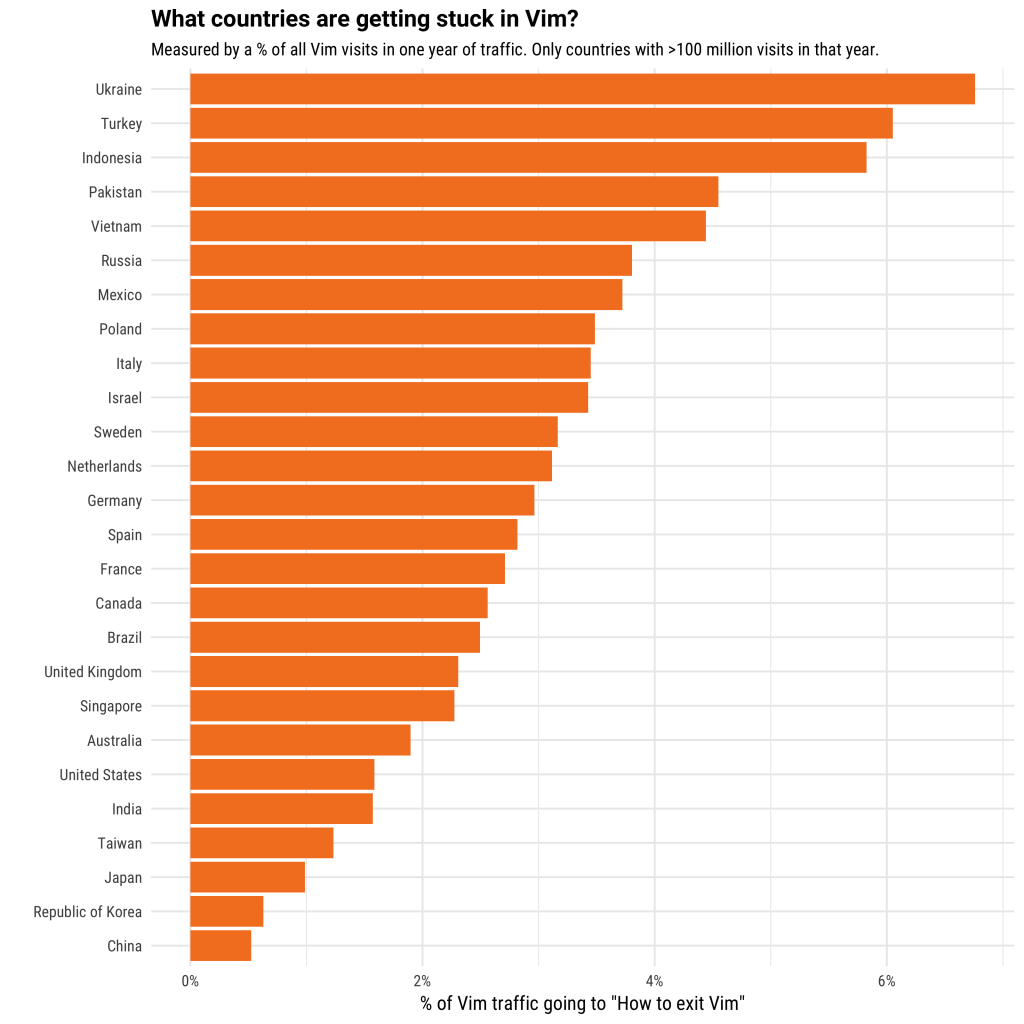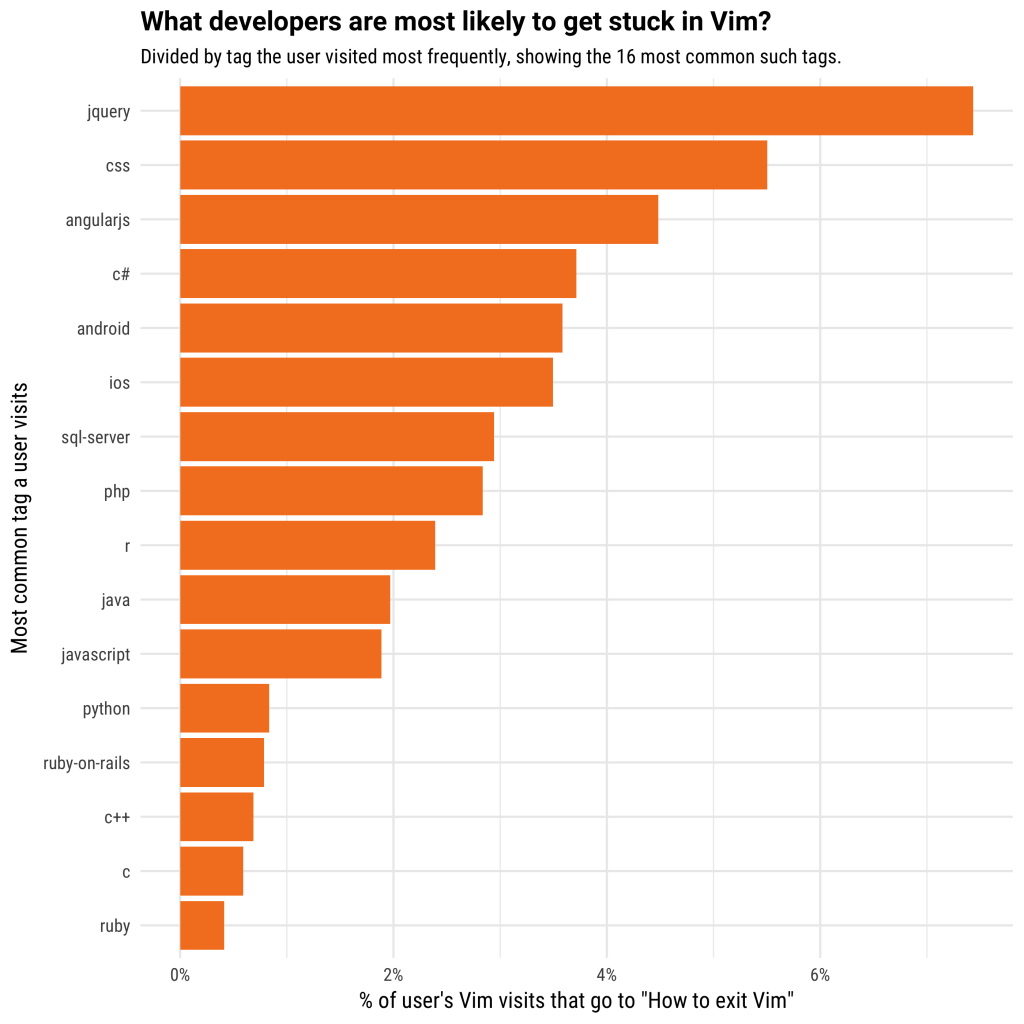Stack Overflow brought more than a million users out of Vim
The other day a popular question on Stack Overflow celebrated its millionth anniversary jubilee.

You are not alone, jclancy. In the five years that have passed since this post was published, more than a million other developers suffered the same fate - they were stuck in Vim and could not get out without help. No wonder there are so many jokes in the IT community about how difficult it is to find a way out of this editor.
')

From experienced users of Vim, I heard that the editor does not deserve such a reputation, and they are probably right (even I myself have dealt with this problem over the past couple of years). I think there are two reasons why people constantly forget how to get out of Vim. First, developers, as a rule, transfer to Vim from the console or as a result of some other unforeseen situation; secondly, this does not happen too often, so they have time to forget how they got out of the situation last time.
To celebrate this event, let's look at the statistics. In particular, we will try to figure out who most often gets stuck in Vim, and does not turn out there intentionally, and see how these categories are distributed across countries and programming languages.
How many people have trouble getting out of Vim?
Last year, about 0.05% of the total number of views accounted for questions like “ How to exit the editor Vim? "; This means that every 20,000th visitor came to the site with this very problem. In other words, on weekdays when the traffic reaches a peak, about 80 people per hour need help getting out of Vim.
Has this percentage changed over time? That is, is it possible to say that the developers gradually master this function on their own?

Something does not look like. The question appeared on the site in August 2012, the first few months, the number of views he had was very low. Then the traffic began to grow steadily and for two years remained on the rise - probably the page climbed to the first lines of the search results and third-party resources began to refer to it. In the next two years, the increase was fairly stable. Of course, this does not mean that the same people come to the page time after time - perhaps these are new programmers who got into this situation for the first time.
Country Statistics
As we mentioned in one of the previous posts , the Stack Overflow traffic analysis allows you to learn a lot about the geographical distribution of developers. Let's see what percentage are the questions about the withdrawal of the total number of posts related to Vim for each country. We assume that in countries where there are many experienced Vim users, the percentage will be low. Large values, on the contrary, indicate that many developers get into Vim unexpectedly for themselves.

As you can see, programmers from Ukraine, Turkey and Indonesia quite often get stuck in this editor: the share of questions about Vim related directly to the exit from the program, they have more than all other countries. At the opposite end of the spectrum are China, Korea and Japan - they have a percentage of such requests less than a good ten times. From this, it seems, it should be concluded that the developers from these countries come to Vim not by chance and are well aware of what to do to get out.
What languages do those who cannot cope with Vim write?
It also seems logical that the language in which a programmer writes code will influence the experience with Vim. We can test this hypothesis as follows: we divide users into groups according to the basic programming technology and look at the average percentage ratio “questions on exiting Vim” / “questions on Vim” for each group.
We will determine the main programming technology on the basis of which tag on Stack Overflow a user visits most often (for example, in my case the most popular tag is R, it accounts for 52% of views). The method is not ideal, but reliable enough to provide a general outline of the distribution by language. For this part of the analysis, we included only registered users who have more than 100 site views.

Most often, the difficulty in leaving Vim comes from front-end developers — that is, those who mostly look at JQuery, CSS, and AngularJS tags. They are followed by Microsoft developers (C # and SQL Server) and mobile developers (Android and iOS). They work mostly with integrated development environments (Visual Studio, Eclipse, Xcode, and so on), rather than simple text editors, so it’s not surprising that they are more likely to please Vim by chance than to open it intentionally.
The developers who are least likely to stump are writing C, C ++, Python and Ruby. This list, in my opinion, is quite natural: it is a mixture of low-level and script languages, which usually involve a simple text editor without a graphical shell. Accordingly, those who work with these languages have enough experience to exit Vim without resorting to Google.
Conclusion
When I saw that the number of views of the question was approaching the mark of a million, it amused me, but at the same time, I felt proud to work (and, among other things, answer questions) on the site, which turned out to be useful to such a huge amount developers. Just think: the answer you are proposing can help millions of people, no matter what they are talking about - canceling a command in git or using the yield keyword in Python .
If you also want to contribute, we invite you to join the largest developer community in the world in any role that suits you - ask questions and offer answers, get a job or make a name for yourself online by publishing your story . You can also use our tools, for example, Stack Overflow Trends , which will allow you to learn a lot about software developers.
In any case, the next time you solve a problem thanks to Stack Overflow, do not forget that thousands of users ask questions daily, post answers, edit and moderate posts to give you that opportunity.

You are not alone, jclancy. In the five years that have passed since this post was published, more than a million other developers suffered the same fate - they were stuck in Vim and could not get out without help. No wonder there are so many jokes in the IT community about how difficult it is to find a way out of this editor.
')

From experienced users of Vim, I heard that the editor does not deserve such a reputation, and they are probably right (even I myself have dealt with this problem over the past couple of years). I think there are two reasons why people constantly forget how to get out of Vim. First, developers, as a rule, transfer to Vim from the console or as a result of some other unforeseen situation; secondly, this does not happen too often, so they have time to forget how they got out of the situation last time.
To celebrate this event, let's look at the statistics. In particular, we will try to figure out who most often gets stuck in Vim, and does not turn out there intentionally, and see how these categories are distributed across countries and programming languages.
How many people have trouble getting out of Vim?
Last year, about 0.05% of the total number of views accounted for questions like “ How to exit the editor Vim? "; This means that every 20,000th visitor came to the site with this very problem. In other words, on weekdays when the traffic reaches a peak, about 80 people per hour need help getting out of Vim.
Has this percentage changed over time? That is, is it possible to say that the developers gradually master this function on their own?

Something does not look like. The question appeared on the site in August 2012, the first few months, the number of views he had was very low. Then the traffic began to grow steadily and for two years remained on the rise - probably the page climbed to the first lines of the search results and third-party resources began to refer to it. In the next two years, the increase was fairly stable. Of course, this does not mean that the same people come to the page time after time - perhaps these are new programmers who got into this situation for the first time.
Country Statistics
As we mentioned in one of the previous posts , the Stack Overflow traffic analysis allows you to learn a lot about the geographical distribution of developers. Let's see what percentage are the questions about the withdrawal of the total number of posts related to Vim for each country. We assume that in countries where there are many experienced Vim users, the percentage will be low. Large values, on the contrary, indicate that many developers get into Vim unexpectedly for themselves.

As you can see, programmers from Ukraine, Turkey and Indonesia quite often get stuck in this editor: the share of questions about Vim related directly to the exit from the program, they have more than all other countries. At the opposite end of the spectrum are China, Korea and Japan - they have a percentage of such requests less than a good ten times. From this, it seems, it should be concluded that the developers from these countries come to Vim not by chance and are well aware of what to do to get out.
What languages do those who cannot cope with Vim write?
It also seems logical that the language in which a programmer writes code will influence the experience with Vim. We can test this hypothesis as follows: we divide users into groups according to the basic programming technology and look at the average percentage ratio “questions on exiting Vim” / “questions on Vim” for each group.
We will determine the main programming technology on the basis of which tag on Stack Overflow a user visits most often (for example, in my case the most popular tag is R, it accounts for 52% of views). The method is not ideal, but reliable enough to provide a general outline of the distribution by language. For this part of the analysis, we included only registered users who have more than 100 site views.

Most often, the difficulty in leaving Vim comes from front-end developers — that is, those who mostly look at JQuery, CSS, and AngularJS tags. They are followed by Microsoft developers (C # and SQL Server) and mobile developers (Android and iOS). They work mostly with integrated development environments (Visual Studio, Eclipse, Xcode, and so on), rather than simple text editors, so it’s not surprising that they are more likely to please Vim by chance than to open it intentionally.
The developers who are least likely to stump are writing C, C ++, Python and Ruby. This list, in my opinion, is quite natural: it is a mixture of low-level and script languages, which usually involve a simple text editor without a graphical shell. Accordingly, those who work with these languages have enough experience to exit Vim without resorting to Google.
Conclusion
When I saw that the number of views of the question was approaching the mark of a million, it amused me, but at the same time, I felt proud to work (and, among other things, answer questions) on the site, which turned out to be useful to such a huge amount developers. Just think: the answer you are proposing can help millions of people, no matter what they are talking about - canceling a command in git or using the yield keyword in Python .
If you also want to contribute, we invite you to join the largest developer community in the world in any role that suits you - ask questions and offer answers, get a job or make a name for yourself online by publishing your story . You can also use our tools, for example, Stack Overflow Trends , which will allow you to learn a lot about software developers.
In any case, the next time you solve a problem thanks to Stack Overflow, do not forget that thousands of users ask questions daily, post answers, edit and moderate posts to give you that opportunity.
Source: https://habr.com/ru/post/329514/
All Articles